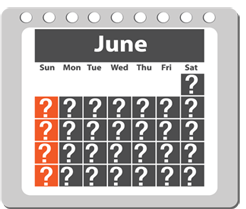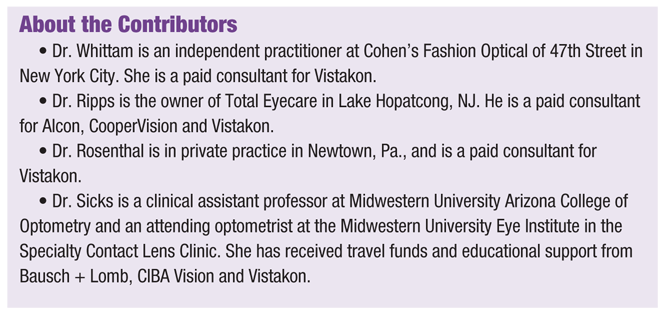Typically, that is as short a replacement cycle as possible. In more than 30 years of practice, I have learned that a shorter wear schedule means a cleaner lens and fewer complaints. Most importantly, I try not to let cost be a factor––at least in my initial recommendation. If cost becomes a problem, we can re-evaluate that selection and turn to a “next best” solution.
And no matter what replacement schedule one selects, patient compliance with that schedule is the key to comfortable, healthy wear. We perform specular microscopy as part of our routine screening for all contact lens patients, and have found that endothelial cell counts and images of the endothelium are an excellent teaching tool to help us emphasize ocular health, show endothelial cell damage that occurs from overwear, and reinforce the importance of changing contact lenses on schedule.
I asked several other clinicians to offer their thoughts on the ideal schedule. They said their preferred replacement schedule is….
 |
| Which replacement schedule works best for
your patients? |
New York City’s Denise Whittam, OD, says she strongly prefers daily disposable modalities, recommending them for teens and young wearers, but also suggests that established wearers consider this option. “They dramatically reduce the build-up of lipids and proteins, which can lead to lid irritation, decreased comfort and giant papillary conjunctivitis,” she says.
Dr. Whittam stresses that discomfort and dissatisfaction with contact lenses can begin earlier than many practitioners expect. “Even in their 20s, patients start shortening the hours of wear per day or skipping contact lenses when they don’t ‘have’ to wear them,” she says. “That’s the beginning of a slide toward intolerance and dropout.” So, when a patient comes in for an annual exam and claims to be doing “fine,” Dr. Whittam probes a little deeper. “I usually find out that their lenses don’t feel as good at the end of the day as they do in the morning and they don’t feel as good on week two or three as they did when the package was first opened,” she says. “Moving that patient into a daily disposable lens is a great opportunity to enhance their comfort and really wow them.”
She also sees a lot of people who only wear contact lenses for social events or weekend sports. A daily disposable lens is a better option for patients who might otherwise be storing their contact lenses for a week or more between uses, she says. “When lenses are left in the same solution too long, salt precipitate forms in the case and the solution efficacy changes, often leading to corneal issues and eye infections,” Dr. Whittam says.
Because it avoids problems associated with changes in the pH, osmolarity and antimicrobial properties of solutions when left dormant in cases, Dr. Whittam switches such patients to a daily disposable—and often the experience starts to override their objections to full-time wear, she adds.
Communicating value is the answer to cost concerns, says Dr. Whittam. “Just like there are solid reasons to pay for air conditioning and anti-lock brakes in your car or a better camera on your phone, there have been real advancements in contact lens technology that are worth the additional cost.”
She finds that a trial of daily disposable lenses improves acceptance. “By giving patients the opportunity to see the value for themselves, they end up loving the lenses and, even better, the doctor who prescribes them.”
…Weekly
Not many contact lenses are manufacturer-recommended for one-week replacement, but Bradford Ripps, OD, of northwest New Jersey says this replacement cycle is one he commonly recommends. “If I can’t fit a patient in daily disposable lenses, my next choice is weekly replacement,” he says. That could mean choosing a lens specified for one-week replacement, or simply recommending more frequent replacement of a two-week or even a monthly lens if it will be a better fit or come in the ideal parameters.
“In my experience, even patients prone to problems tend to experience them later in the wear cycle,” Dr. Ripps says. “At one week, they rarely have build-up or discomfort.”
Additionally, he says, patients find it very easy to comply with a one-week replacement schedule because they just pick a day of the week and always open a new pack of lenses that morning.
On costs, “we need to stay out of the patient’s pocketbook,” he says. “Most people place a high value on great vision and a successful lens-wearing experience, and that’s what I try to provide. If patients truly can’t afford to change their lenses every week or every day, we can fit them with an inexpensive pair of glasses, or perhaps glasses and daily disposable lenses for occasional use,” he says.
Dr. Ripps tells patients exactly why he recommends weekly replacement so they aren’t surprised if a friend or family member with the very same lenses is wearing them for a longer stretch. He’s been doing this for years—and says the feedback from patients has been very positive. “Patients have terrific success with this abbreviated wear schedule,” he says. “The bottom line is that more frequent replacement is better for our patients.”
…Two-Week
Robert Rosenthal, OD, of Newtown, Pa., says that while he won’t compromise vision, health or comfort just to pick a particular modality, he most often reaches for a two-week lens.
“They are available in most parameters, are at a reasonable price point, and fill the comfort niche perfectly,” he says. And for him, comfort trumps almost every other consideration in fitting contact lenses.
“Most contact lenses offer good initial comfort,” he says. “But more important than how the lenses feel when the patient is sitting in the chair is how they feel at the end of the day and at the end of the replacement cycle.” He takes care to select lenses with advanced wetting technologies that improve comfort. Particularly compared to a monthly lens, Dr. Rosenthal feels that two-week replacement offers advantages in health and the consistency of vision, too.
“I don’t see any compliance disadvantage with two-week replacement either, because I believe the doctor has a lot of ways to positively influence compliance,” he says. For example, he almost always dispenses an annual supply. And in talking with patients, he doesn’t just ask how frequently they change their lenses. “My next question is, ‘How do you remember when to change them?’ If the answer is ‘I just do,’ then I know we have a problem,” he says.
Automated reminder notifications sent by email or text can help, as can showing them visuals of potential contact lens complications (such as those on the Efron grading scale).
“They give patients an immediate, visual understanding of the potential consequences of poor compliance,” he says.
Lens manufacturers also offer an array of patient education and reminder tools to help the cause. A Vistakon study of its Acuminder tool, presented at last year’s BCLA meeting, showed that electronic reminders improved patient diligence in adhering to schedule. Wearers of two-week lenses increased their replacement frequency from an average of 19.9 days to 14.7 days; monthly wearers improved from 35.6 to 30 days.
What Dr. Rosenthal never does is move patients into a longer replacement schedule. “I don’t think stepping back to a monthly lens that may compromise comfort is going to truly address the problem, so I’m more likely to go a shorter wear schedule if compliance is an issue,” he says.
…Monthly
Lindsay Sicks, OD, of Glendale, Ariz., says that monthly replacement varieties are available in the widest array of parameters among off-the-shelf lenses. “Different base curve availability within lens brands help in troubleshooting lens fit issues,” she points out. And, a wide array of available powers (sphere, cylinder, and axis) mean that even more prescriptions can be fit on the first visit to your office without having to special order a new trial lens. “Ultimately, this means less administrative work for you and more solutions for more patients in your practice.” Monthly replacement may also allow you to easily transition a patient to the convenience of extended or continuous wear without re-fitting into a completely different lens.
Monthly replacement lenses are the most cost-effective modality for patients today, she says, when lenses are worn full time, citing the lowest “cost-per-wear” number for monthly lenses (accounting for professional fees and the cost of solutions) when compared to two-week replacement and daily disposable lenses.1 This affordability keeps monthly replacement lenses remain popular among patients. “To capitalize on this cost-conscious segment of the population, we can easily stock the most commonly prescribed lenses in-office for same-day purchase to increase retail sales,” Dr. Sicks says.
She also points to studies showing that compliance with recommended replacement frequency for patients in one month replacement lenses is higher than that of two week lenses.2,3 A 2010 study by Kathy Dumbleton, MSc, MCOptom, showed that one-month replacement lenses had not only better end-of-day comfort, but also better comfort when the lenses were near replacement when compared to the same circumstances with two-week replacement lenses. “It may just simply be easier for patients to remember to change their lenses once a month,” Dr. Sicks says. “With the pervasive nature of smartphones, it may even be a good idea to educate patients, while they are in the chair, to set a phone alarm reminder on the day they are to change their lenses.” You can start this process by dispensing a new pair of trial lenses that day and reinforcing the date to change before the patient leaves the office, she suggests.
 Conclusions
Conclusions
These are all valid perspectives to factor into the decisions you make about what to recommend for your own patients.
If there is one key takeaway from this article, it should be that the best replacement schedule is the one that suits the patient in your chair. Each patient’s needs, prescription and lifestyle should guide your decision, rather than some arbitrary replacement preference to the exclusion of all others.
And with the wide variety of advanced contact lens materials and modalities available today, the good news is that there should be a contact lens to suit almost every patient’s needs.
Dr. Krivacic is the founder of Las Colinas Vision Center in Irving, Texas, and has been involved in clinical trial research for Alcon and Ciba Vision. He is a member of the American Optometric Association, the Texas Optometric Association and the North Texas Optometric Society.
1. Efron N, Efron SE, Morgan PB, Morgan SL. A ‘cost-per-wear’ model based on contact lens replacement frequency. Clin Exp Optom. 2010;93:253-60.
2. Dumbleton K, Richter D, Woods C, et al. Compliance with contact lens replacement in Canada and the United States. Optom Vis Sci. 2010 Feb;87:131-9.
3. Dumbleton K, Woods C, Jones L, et al. Patient and practitioner compliance with silicone hydrogel and daily disposable lens replacement in the United States. Eye Cont Lens. 2009 Jul; 35 (4):164-71.


